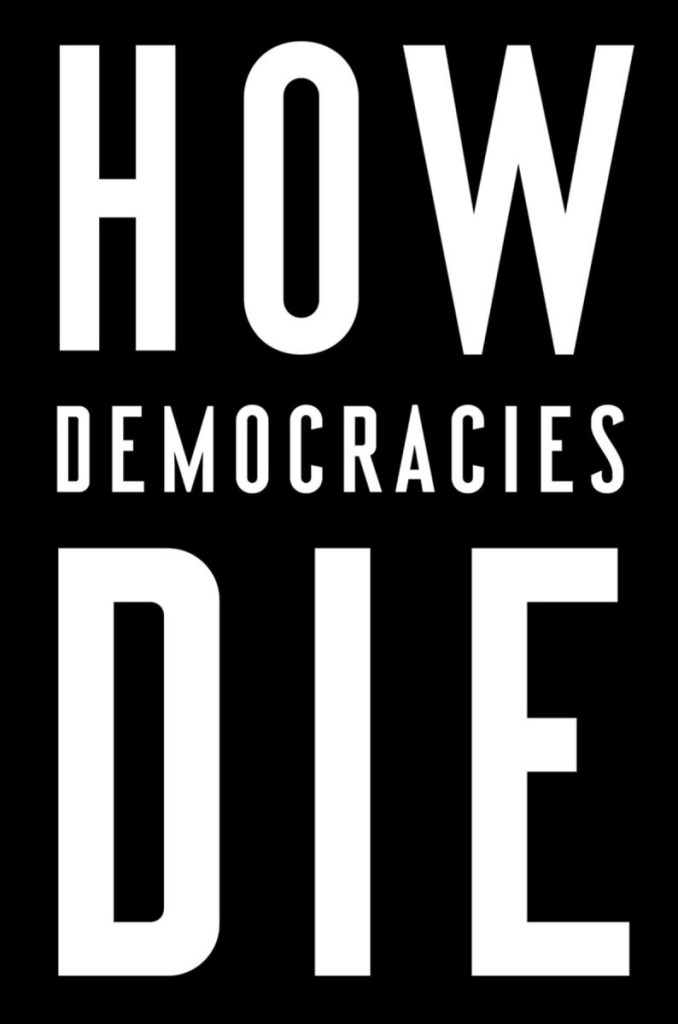In case you haven’t noticed, the much-vaunted democracy of the United States of America is in a strange place right now. Its leader, President Trump, has threatened to jail yet another of his political opponents (this time former Hillary Clinton aide Huma Abedin) and sue the author of a critical book about his presidency – and that’s just this year. Previously, he publicly impugned the character of federal judges, described the news media as “the enemy of the American people” and demanded an oath of personal loyalty from his FBI director. He lies relentlessly and still hasn’t released his tax returns.
Many of Trump’s supporters – a diehard group comprising a bit more than a third of the electorate – continue to applaud. His enemies can barely endure the sight of him. The country hasn’t been so divided for the past half-century. Can our polity survive the strain?
In this respect, “How Democracies Die” comes at exactly the right moment. We’re already awash in public indignation – what we desperately need is a sober, dispassionate look at the current state of affairs. Steven Levitsky and Daniel Ziblatt, two of the most respected scholars in the field of democracy studies, offer just that. Their book starts by giving us a readable but thorough look at democratic breakdowns in societies around the world. They then compare those incidents with current developments in the United States – and arrive at some disturbing conclusions.
I can already hear the sneers from Trump’s defenders: These guys are just another pair of hysterical snowflakes trying to turn the Donald into the next Hitler. Do they have a point? This is the United States, after all. We have a Constitution that has stood the test of time. We have deeply rooted institutions, some of which have vigorously resisted the president’s more destructive impulses. Surely our defenses against authoritarianism are solid.
To this, Levitsky and Ziblatt offer a cool and persuasive response. For one thing, they note, the United States has never been immune to democratic breakdown: “Writing this book has reminded us that American democracy is not as exceptional as we sometimes believe.” The Founding Fathers themselves indulged in emphatically zero-sum politics. The country’s first two political parties, the Federalists of Alexander Hamilton and the Democratic-Republicans of Thomas Jefferson, wanted to annihilate each other.
That era of confrontation gradually gave way to a period of partisan coexistence and compromise, until the mid-19th century, when U.S. politicians began displaying open contempt for the rules of fair political play. The authors cite one historian who has tracked 125 examples of violence – “including stabbings, canings, and the pulling of pistols” – on the floor of the House and Senate between 1830 and 1860. And of course, the Civil War, which took 600,000 lives, was not exactly a high point in the story of American liberty.
The end of Reconstruction ushered in another period of comparative political civility – but only because Southern Democrats were tacitly allowed to set up a regime of one-party rule that systematically disenfranchised African-Americans. “Mutual toleration was established only after the issue of racial equality was removed from the political agenda,” the authors write.
In the 20th century, populist demagogues such as Henry Ford, Huey Long and Charles Coughlin showed that large numbers of Americans were willing to tolerate open challenges to democracy. And even the lionized Franklin Roosevelt, in a stunning display of illiberalism, tried to pack the Supreme Court, prompting a bipartisan backlash.
The postwar period was another era of trans-party cooperation, at least for a while. “The process of racial inclusion that began after World War II and culminated in the 1964 Civil Rights Act and 1965 Voting Rights Act would, at long last, fully democratize the United States,” the authors note. “But it would also polarize it, posing the greatest challenge to established forms of mutual toleration and forbearance since Reconstruction.”
In the ensuing decades, the political parties have gone from “big tents” that embraced a wide range of constituencies to ideologically homogeneous camps that are naturally less inclined to seek common ground and compromise. Today’s parties, Levitsky and Ziblatt write, “represent not just different policy approaches but different communities, cultures, and values.” The problem is amplified by gerrymandering, polarizing cable news and social media, and Americans’ growing tendency to “self-sort” into communities of the like-minded.
So what about our storied institutions? Surely they must be up to the task of containing this new era of partisan rancor. Levitsky and Ziblatt aren’t so sure. Their studies of democratic collapse in other places around the world show that even well-established legislatures, courts and constitutions become vulnerable when leaders – particularly “populist outsiders” – begin to violate accepted norms of political behavior. Citing examples from Venezuela to Turkey, the authors carefully track the warning signs: Contempt for democratic rules of the game, such as a willingness to violate the constitution. Attacks on the legitimacy of political opponents. Tacitly encouraging violence and a readiness to curtail civil liberties, including freedom of the media.
Trump, the authors note, is guilty on all four counts. At the same time, they list a plethora of ways national institutions and, above all, ordinary citizens can summon the means to defend against our president’s most dangerous instincts. But Levitsky and Ziblatt don’t leave it at that. The problems of American democracy, they note, don’t stop with our president. He is, they conclude, a particularly dangerous symptom of a much broader malaise.
Send questions/comments to the editors.



Comments are no longer available on this story